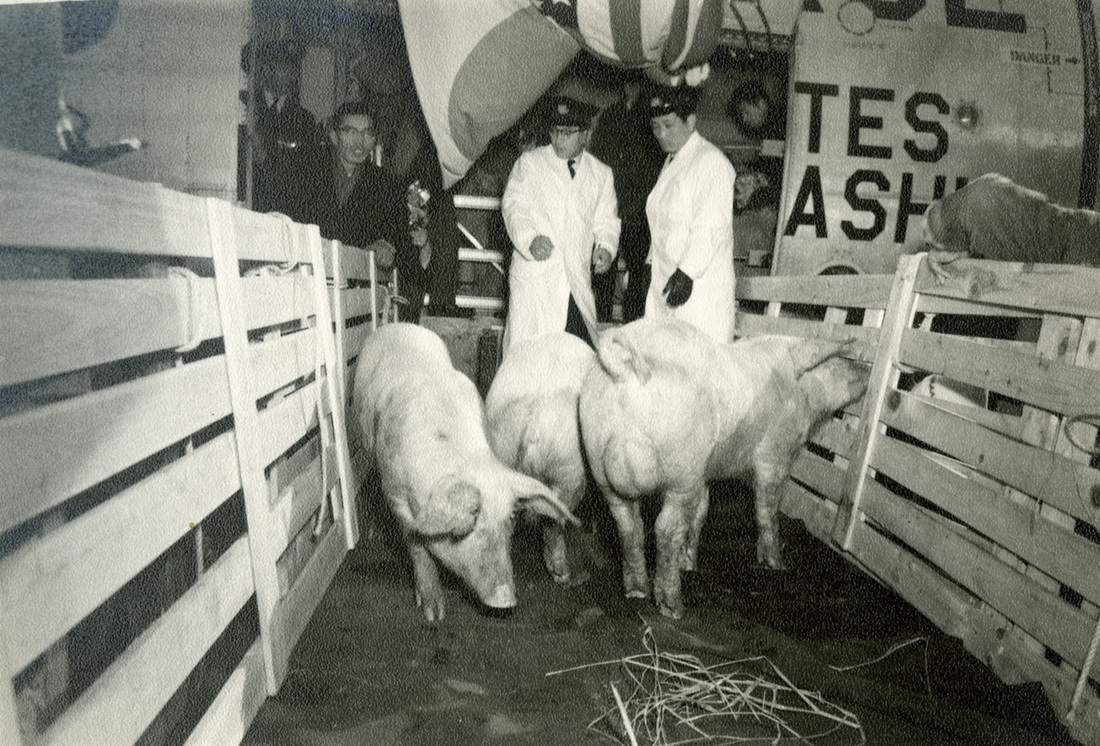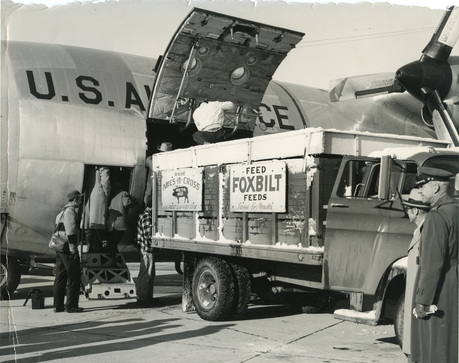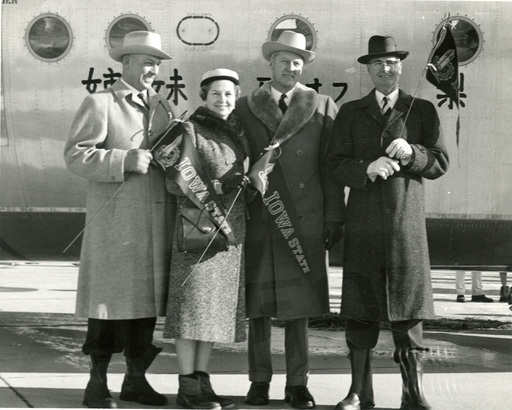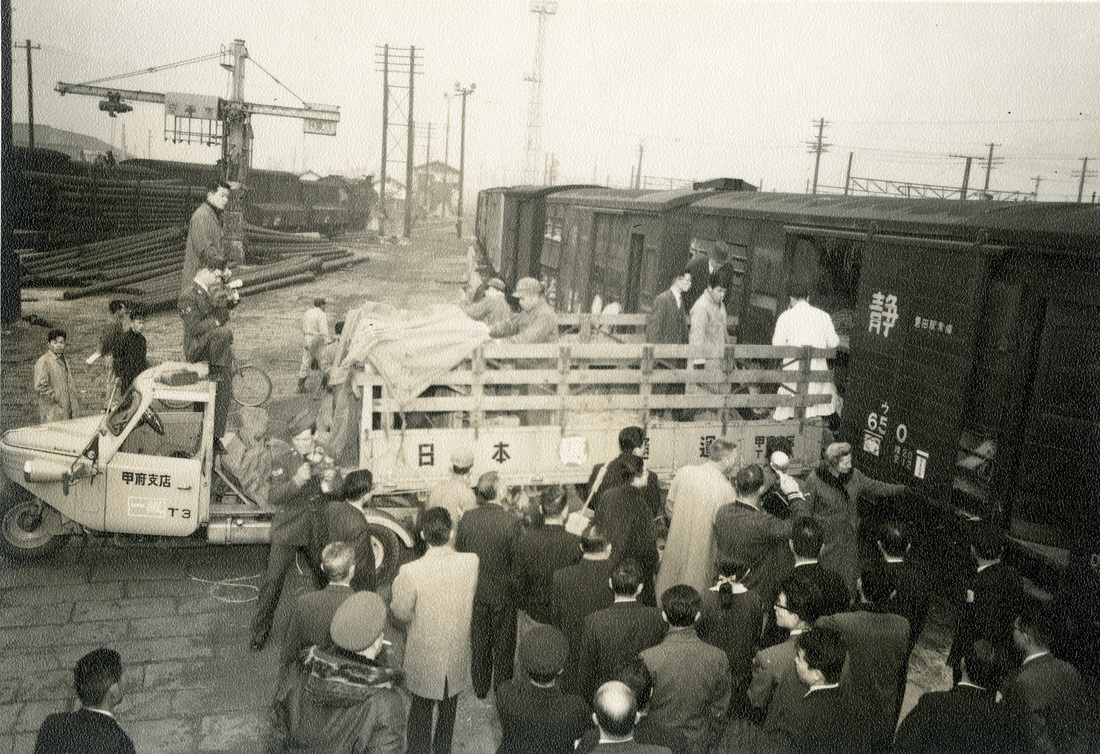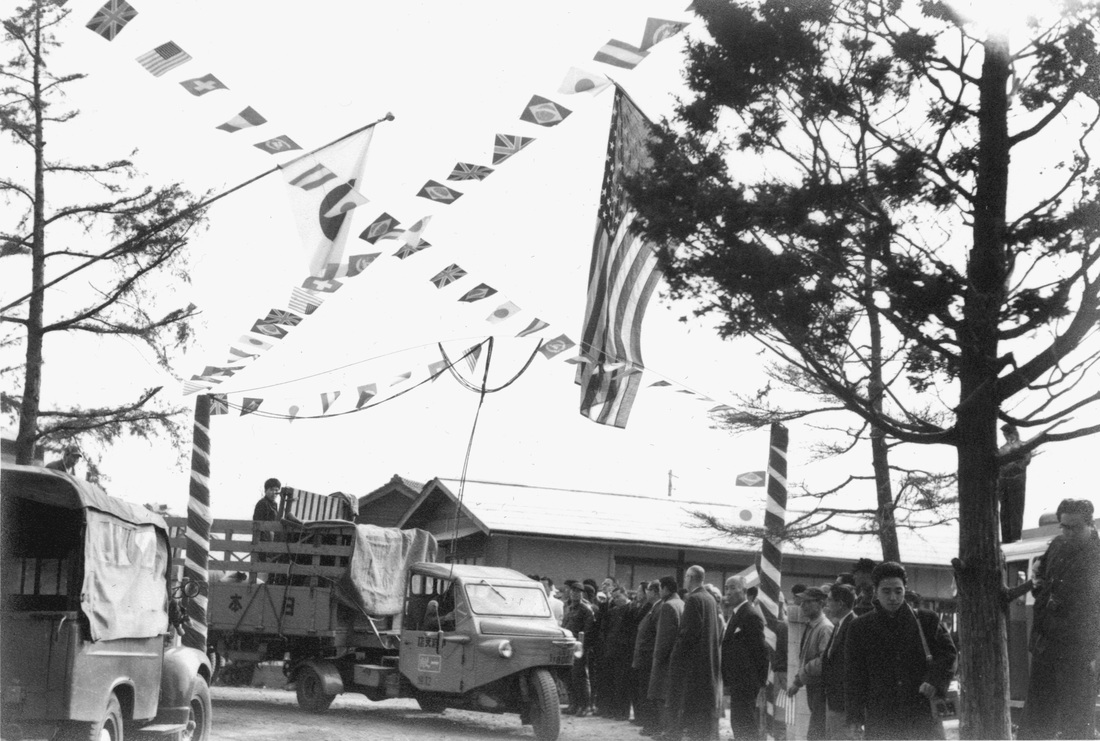A Revolutionary Idea Take Flight
Richard Thomas proposed his idea to Don Motz, the U.S. agricultural attaché at the embassy in Tokyo, who helped work out the details. The Air Force flew Thomas to Iowa where the "hog lift" received enthusiastic support. Walter Goeppinger, president of the National Corn Growers Association (NCGA), had been searching for ways to open global markets for Iowa grain. Thomas' efforts in citizen diplomacy extended to Washington, D.C., where the USDA Foreign Agricultural Service and the Japanese agricultural attaché, Hideo Tokoro, agreed to help.
"Iowa farmers donated 36 hogs for the project. The Agriculture Department agreed to provide 60,000 bushels of corn for feed from government stocks, but only after department officials were convinced of 'the possibility of selling large amounts' of grain there."
~Walter Goeppinger 1980 memorandum, quoted in Des Moines Register.
~Walter Goeppinger 1980 memorandum, quoted in Des Moines Register.
The U.S. Air Force supplied a plane for the hogs; grain was transported to Japan by ship. According to the U.S. Grains Council:
"Getting the hogs to Japan was no easy task. Roscoe Marsden, president of the Iowa Corn Growers Association, rounded up 36 lean meat breeding hogs donated by Iowa farmers. The animals were shipped on an Air Force Cargo plane fitted with special crates. Accompanying the hogs were Marsden, his wife Kay, and NCGA director Albert Miller. Because there were no jet cargo planes at the time, the hogs and their escorts were forced to take a time-consuming, treacherous, island hopping flight across the Pacific. At each stop, Miller and Marsden would bathe the hogs so that the animals wouldn't overheat."
~U.S. Grains Council, "Issue 1: How Iowa Hogs Helped Make Japan U.S. Farmers' Top Export Market for U.S. Feed Grains."
"Getting the hogs to Japan was no easy task. Roscoe Marsden, president of the Iowa Corn Growers Association, rounded up 36 lean meat breeding hogs donated by Iowa farmers. The animals were shipped on an Air Force Cargo plane fitted with special crates. Accompanying the hogs were Marsden, his wife Kay, and NCGA director Albert Miller. Because there were no jet cargo planes at the time, the hogs and their escorts were forced to take a time-consuming, treacherous, island hopping flight across the Pacific. At each stop, Miller and Marsden would bathe the hogs so that the animals wouldn't overheat."
~U.S. Grains Council, "Issue 1: How Iowa Hogs Helped Make Japan U.S. Farmers' Top Export Market for U.S. Feed Grains."
"We're sending pigs that weigh around 130 pounds, farrowed last spring or summer. We're doing that deliberately because we want the Japanese to see the pigs 'grow up' under our methods of feeding.
"It's a way that we could develop a market for feed grains.... [Japan] could become an awfully big market for our surpluses."
~Walter Goeppinger, quoted in the Des Moines Register, January 10, 1960
"It's a way that we could develop a market for feed grains.... [Japan] could become an awfully big market for our surpluses."
~Walter Goeppinger, quoted in the Des Moines Register, January 10, 1960
Iowa Hogs Arrive in Yamanashi
After a two-week quarantine in Tokyo, the 35 surviving hogs (one died en route) were transported to the Shumiyonshi Breeding Station in Kofu, the capital of Yamanashi.
"The hogs lived out their lives in new facilities and populated the prefecture with their descendants. Official estimated that by the time the last of the original hogs died nine years later, their progeny totaled some 500,000 feed grain-guzzling animals."
~U.S. Grain Council
"The hogs lived out their lives in new facilities and populated the prefecture with their descendants. Official estimated that by the time the last of the original hogs died nine years later, their progeny totaled some 500,000 feed grain-guzzling animals."
~U.S. Grain Council
"This is a warm hand of friendship extended across the sea. It is the spirit of the people-to-people program expressed in the most realistic as well as the most sublime of terms. Like these hogs you have presented, the seed of friendship you have planted will increase itself, producing generations of blue ribbon friends and good will of the purest strain."
~Hideo Tokoro, Japan's agricultural attaché to the U.S.
~Hideo Tokoro, Japan's agricultural attaché to the U.S.
An Unsung Hero
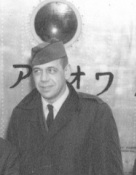
Richard Thomas initiated efforts that united farmers, government officials, and agricultural agencies at home and abroad that resulted in the hog lift--and opened the door for lasting partnerships between Iowa and Yamanashi, and on a larger scale, the U.S. and Japan.
Video: TV Yamanashi (Japan) and KCRG TV (Cedar Rapids, Iowa)
